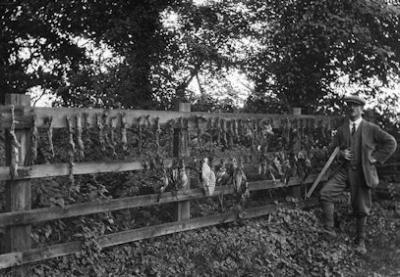Following his appointment as Head Teacher of the Church School in 1908, Percy Robinson built up an extensive knowledge of Trumpington’s history. One of his individual notes from the early 1920s is about local birds and animals, reproduced below.

Bird and animal life
Although so close to the town of Cambridge, the private lands in Trumpington may well be regarded as a sanctuary for bird, animal and insect life.
Some of the prettiest and rarest of British birds are by no means uncommon. Kingfishers , woodpeckers, magpies, jays, herons , kestrel and sparrow hawks, pheasants, partridges, snipe , goldcrest, firecrest, hawfinch, Bohemian waxwing, waterrails, coot, moorhen, dabchick or little grebe, corncrake, owls, wild duck, peewit or plover, golden plover and a host of smaller birds may often be seen in their natural element on a fine summer’s day providing one has permission to cross the land and knows the direction to take. The crossbill has also been seen but not often.
The fox is the largest of our wild animals, and a vixen has “cubbed down” for a number of years in succession; on occasions the mother with her five little ones could be seen gambolling in the mornings and evenings by a precautious watcher. The lair of the creature was in the midst of a rabbit warren, and the rabbits appeared to ignore the intruders to their domain.
Otters are far too plentiful from a fisherman’s point of view, but owing to the depth of water the hounds find it difficult to kill. Their food is very plentiful, pike up to 17¼ lbs. weight, bream 5¼ lbs,, roach 2¼ lbs., chub 5¼ lbs., trout 4¼ lbs., perch 1¾ lbs., have been taken by fishermen, but with the exception of the bream mentioned, I know of no others – not even small ones – having been taken.
Stoats and weasels play havoc with the game, but they are well looked after by the gamekeepers, as a view of the “gibbet” will show. Polecats are very scarce but have been seen,
From an entomological point of view Trumpington may vie with Wicken Fen as a collectors’ rendezvous. The death’s head moth was plentiful about 1900 when pupae sold at 2d. each when potatoes were lifted, goat, puss, leopard, convolvulus hawk, privet hawk, elephant hawk, lime hawk, hummingbird hawk, lobster, with a large number of other moths and butterflies, are to be obtained by enthusiastic collectors.
Of butterflies the clouded yellow has been taken some years upon clover, but the choicest Hyale (Pale clouded yellow) has also been captured.
One instance is recorded of a variety between a Tortoiseshell and Peacock being taken at Trumpington.
Scanned from Percy Robinson’s original typescript by Howard Slatter.